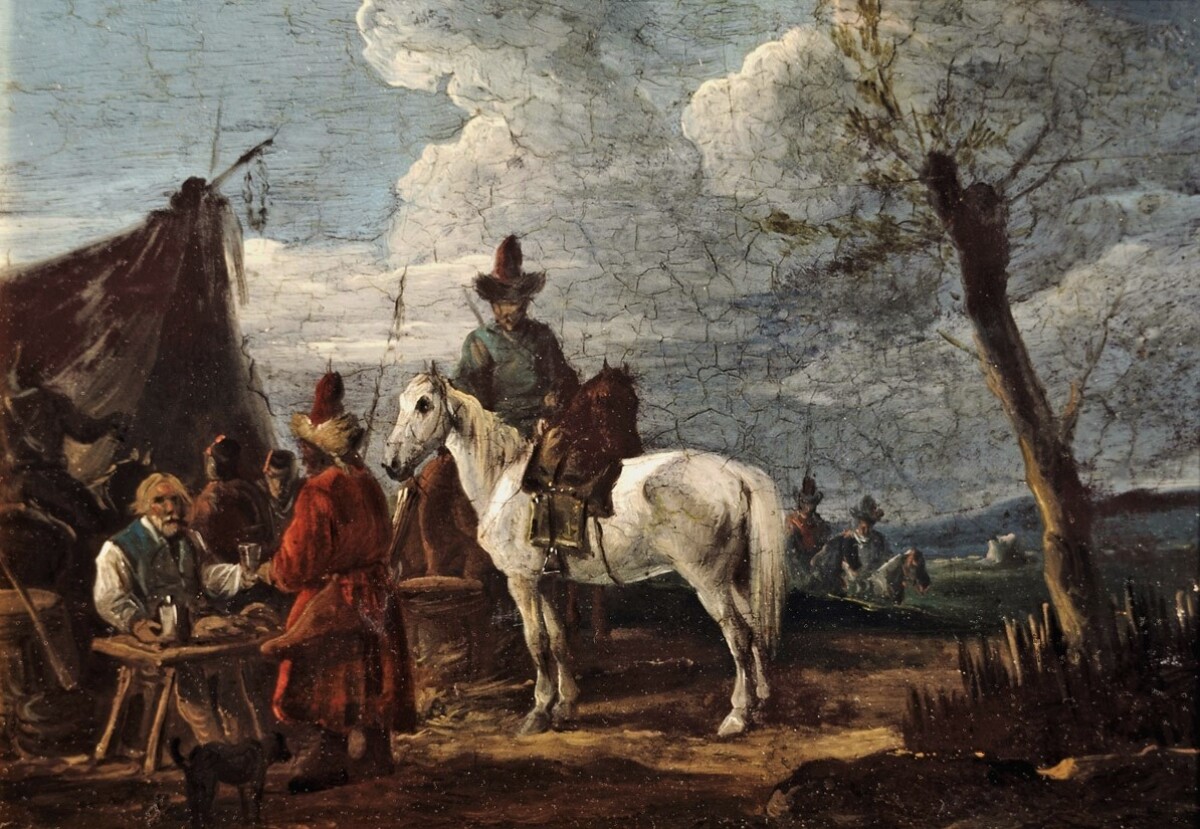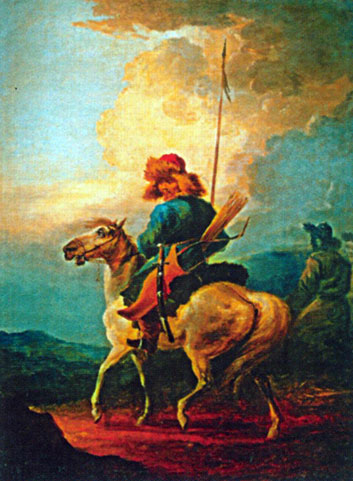
The multinational population of the region assisted Russian army by collecting donations for the needs of the troops. It was livestock, money, clothing, weapons, food, vehicles, etc.
It is known, for example, that a head of the Qazaq tribe “zhappas” Baysakal Tilekuly, Baizhazyk Kushukbayev and some others traveled around the auls (an “aul” means a “village” in Qazaq), collected cattle and food for the army, organized volunteer detachments.
Separate military formations, comprising the Qazaqs, unlike representatives of other nations, were not created (according to historical treaties, the Qazaqs were not called up for regular military service). Therefore, they fought being in the irregular troops, that is, the Ural and Orenburg Cossack regiments, as well as in the ranks of the regiment of foreign mercenaries. The “regiment of foreign mercenaries” was formed in the Orenburg region from the Bashkirs, Tatars, Meshcheraks, Mishars, Mordovians, Teptery, Kalmyks, Nagaybaks, Cheremis, Chuvash and other small peoples of the Volga region.

In the Central State Archive of the Republic of Qazaqstan are kept documents, on the basis of which we can state that Qazaq people were baptized, they accepted Orthodoxy and became a member of the Cossack class. There were very different reasons for that. Often, a member of the Cossack society became those local Qazaqs, who lived from their childhood near the Russian-Qazaqstan boarder. They lost their original roots, spoke Russian well and worked in Cossack villages. It was easy to agitate them, they married to Russians, Tatars, Bashkirs or Kalmyks.
Most of the Qazaqs joined the Orenburg Cossack troops. For example, in 1812, Karybai Arslanbayev from a Qazaq tribe “Kipchak”, Temir Begimov from a Qazaq tribe “Shekty”, Bektemir Kulkin from a Qazaq tribe “Tabyn”, Nurtay Taimasov were taken to the Orenburg Cossacks. When they were baptized, they took on new names and surnames, like: Vasily Petrov, Alexey Osipov, Yegor Leontyev, Yakov and Fyodor Filippov, Evgraf and Semen Vasilyev. But often they left their names, so Cossacks Akhmet Suleymenov, Kurman Khasenov, Ibray Ismailov, Boltai Rakhmankulov and others came across.
A 43-year-old Qazaq woman, Tanatarova (she changed her name to Tatiana) had six sons, who served in the Orenburg Cossack army. All of them fought in the Patriotic War of 1812.
Local Qazaqs moved to the territory of the Bashkir cantons, where they were called as Bashkirs. So, in the period between 1799-1815, 1226 Qazaqs were called Bashkirs (863 men and 363 women). They did it because of a land shortage, difficult economic situation, mutual conflicts, etc. All of them were obliged to perform military service in units of the Bashkir-Meshcheryaksky Cossack regiment, therefore, together with the Russian Cossacks, they went to war with the French army, headed by Napoleon.

At the same time Qazaqs volunteered for the militia. For example, it is known, that sixteen young men from Qazaq tribe “Kipchak” had requested the Ataman of the Orenburg Cossack army to take them for service. One of the volunteers named Zhantore went to war with his young wife. The couple were together in many battles, she showed her excellent equestrian skill and skills as a warrior. She was granted even a battle medal for her bravery. In the memoirs, recorded from the words of Zhantore in 1847, he said about his national dress: “In such a dress I was at war with the French army in a big city, called Paris”. After the war, he and his wife lived in the forest on the banks of the Belaya River. Because of this fact, some historians consider, that Zhantore was Bashkir by nationality. But, by now nobody knows exactly his origin.
In a regiment of foreign mercenaries, the Qazaq warrior-volunteers were allowed to choose their commander, to wear national clothes. In addition to the traditional bow and arrows they used to have Cossack weapons, like: sabers, pikes, and guns. Qazaq warriors had their own horses of local breed. They were unpretentious and accustomed to long-distance crossings. The warriors passed on their backs the whole of Europe, from Moscow through Warsaw and Berlin to Paris and the banks of the Seine.
Armed with ancient weapons, the steppe warriors were an unusual opponent for Napoleonic soldiers. “A small arrow, fired with a strong and skillful hand of a Qazaq, a Bashkir or a Tatar horseman, killed at once the enemy. They skillfully shot at the target and, moreover, with such force that an arrow at a distance of 2 мeters could pierce through not only a man, but a horse, too”, wrote a military historian N.Garnich.

French soldiers recognized a danger, coming from the nomadic warriors. The commander of the 23rd Light Horse Regiment, Baron de Marbo, used to say, the “Bashkirs” (as the French called all non-Russian warriors), were everywhere like a “swarm of wasps”, non-stop firing from their bows. He recalled that it was very difficult to win them, and he himself was easily wounded in the leg “with such a funny bullet”. He wrote that the cavalier of the Order of the Legion of Honor, an officer Maleen got shot in the chest and he died immediately. The French soldiers called the Qazaq soldiers “the northern cupids” for their exotic weapons, that had long been forgotten in Europe.
In total, over 30 irregular cavalry regiments were sent from the Orenburg region to war: five Ural and five Orenburg Cossack regiments, fifteen Bashkir, two Mecheryak, two Kalmyk, two Mishar and one Teptyar regiments. They included Qazaq warriors-volunteers. It is assumed that they served in the first and the second Bashkir regiments, in the first Teptyarsky, the first and the second Orenburg Cossack regiments.
The researcher of the history of the Orenburg region P.Matvievsky wrote that the participation of the Qazaq people in the wars with Napoleon seems completely indisputable and cannot be questioned.
There are pages in history with names of Qazaq warriors, that fought bravely during the Patriotic War of 1812. For example, the Yesaul of Orenburg Cossack troops (“Yesaul” is a post or rank in the Russian and Ukrainian Cossack units), the baptized Qazaq Yakov Belyakov in 1809-1810 participated in the war with Turkey, for courage and bravery was awarded by the commander of the Russian army Mikhail Kutuzov. Later he fought with the French forced army, headed by Napoleon. In 1830, he asked the Orenburg military governor Essen to release him from the service in the army due to his poor health. In his letter to him, Yakov Belyakov wrote that he was a Qazaq by origin, who had voluntarily joined a Cossack society and took part in battles with Napoleon.
Professor Yeltok Dilmukhammedov believed that it was the legendary Major Yakov Belyakov, who was the commander of the third Orenburg Cossack regiment, which fought as part of the troops of General Platov. On March 19, 1814, a regiment of the allied coalition entered Paris and returned home only in 1820. It is difficult to judge whether it is true or not, since, according to other sources, Yakov Belyakov died in April 1816. One thing is clear that in the third Orenburg Cossack regiment was a Cossack Yakov Belyakov (a baptized Qazaq), who was very respected. His name was mentioned in a collection of songs of the Orenburg Cossacks about the Patriotic War of 1812.
Two Qazaqs from a Qazaq tribe “Tama”: Amen Baybatyrov and Narynbay Zhanzhigitov, being on service in one of the Bashkir cavalry regiments, reached Paris. Their regiment bravely fought at Weimar, Hanau, Frankfurt am Main, Koblenz and Mannheim. Baybatyrov showed himself as a true warrior in battles for the cities of Leipzig and Glogau, and was awarded a St. George cross and two medals (according to other sources, three St. George's crosses). Zhanzhigitov was also awarded a silver medal. Both after the war lived in their auls (in Qazaq means “a village”) in the Orenburg steppes.
Baybatyrov became akyn (“a poet-improviser” in Qazaq). He composed songs, where he told about the events, took place during the Russian-French war. He was widely known in the steppe among Qazaq people and the tsarist administration. He made friends with the poet A. Plescheyev, the scientist A. Maksheev and the researcher of the Aral Sea A. Butakov.

A proof of the participation of the Qazaq warriors in the war with Napoleon are the pictures of the battle-painter A. Orlovsky. He painted them in “live” mode, under the impression of his own observations, when the regiments of foreign mercenaries, comprising Bashkirs, Kalmyks, Tatars, Qazaqs and others were on the way to the front.
In the catalog of his works there are oil paintings dedicated to Qazaq soldiers: “A Kirghiz Horseman” (1807), “A Kirghiz Horseman with a pike” (1807), “Kirghizes” (1808), “Two Kirghiz Horsemen” (1809), “A Kirghiz” (1810), “A Kirghiz on a Horse” (1810).
He did 45 drawings on the same topic: “A Kirghiz Patrol” (1807), “A Head of a Bearded Kirghiz in a Round Fur Hat” (1812),” A Kirghiz detachment” (1813), “A Kirghiz camp” (1815), “A Conversation of the Kirghizes with the Ural Cossack” (1817) and others.
In general, among the characters of his paintings and drawings, Cossacks and Kirghizes (that means Qazaqs) can be found more often than Bashkirs, Kalmyks, Tatars and others.
